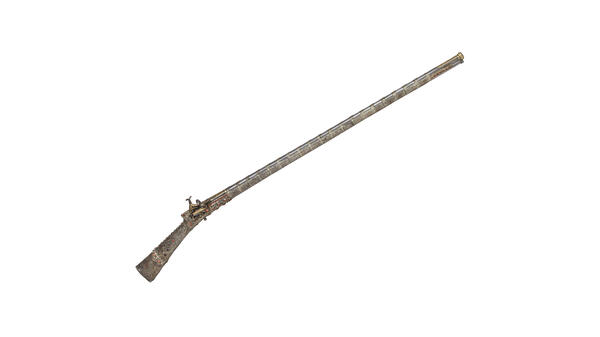Oriental guns have formed an important part of European museum collections. Their unusual design and abundant decoration have always attracted a lot of attention. Apart from their outstanding decoration, guns made on the territory of the Ottoman Empire had several distinctive construction features. Their flintlock mechanisms were similar to those produced by Spanish gunsmiths. The barrels were often made of Damascus steel which gave them greater durability. Barrels were fixed to the stock with bands instead of pins. Moreover, the Ottoman army never used bayonets so there were no mounts for them on the barrel. At the same time, Turkish pistols were almost identical to the European ones, and the only difference lay in the style of decoration. The gunsmith who made the flintlock rifle from the hunting weapons collection of the Gatchina Palace and Estate Museum is unknown. All the stock is covered in silver foil with a repoussé floral pattern and is decorated with corals and garnets near the lock and on the buttstock. Judging by the decorations, the rifle must have been made in the middle of the 18th century in the city of Trebizond. The forged barrel is made of Damascus steel. It is round in section with a narrow flat plane along the top. By the muzzle the barrel is reinforced with a protruding band. At the breech end there is a high arch-shaped sight with an aperture hole. The front sight is made of copper covered in gold foil. The bore has seven semi-circular grooves. The breech end and the muzzle end of the barrel are decorated with images of flower vases inlaid with gold and framed by floral patterns. Among the decorations there is also a palmette — a motif resembling the fan-shaped leaves of a palm tree, similar to a palm or spread fingers of a hand. The reinforcing band by the muzzle is decorated with an in relief gilded pattern of drop-shaped motifs. The silver foil covering the stock and the fore-end near the lock and the muzzle are adorned with corals and almandines of various sizes and shapes. Together they form a pattern of lines, circles and triangles. The barrel is fixed to the stock with a screw, which goes through the stock up to the tang of the breech, as well as with twenty barrel bands. The bands form a seamless whole with silver plates which cover the fore-end — the front part of the stock which runs along the barrel and covers all or a part of its length.
№30 Flintlock rifle
Время создания
mid-18th century
Место создания
Trebizond (?), Ottoman Empire
Размер
overall length — 137.7 cm, barrel length — 105.1 cm, calibre — 13 mm
Техника
forging, casting, wood carving, inlay with gold, repoussé, gilding, stone polishing, bluing
Коллекция
#1
№30 Flintlock rifle
#3
#4
Ministry of Culture of the Russian Federation
читать дальшескрыть
00:00
00:00
1x
№30 Flintlock rifle
Время создания
mid-18th century
Место создания
Trebizond (?), Ottoman Empire
Размер
overall length — 137.7 cm, barrel length — 105.1 cm, calibre — 13 mm
Техника
forging, casting, wood carving, inlay with gold, repoussé, gilding, stone polishing, bluing
Коллекция
Открыть в приложении
Поделиться


